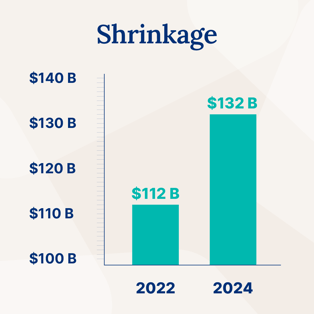What Is Shrinkage in Retail Stores and How to Prevent It

Shrinkage, also known as retail shrink, is a significant concern for the retail industry, impacting profits and inventory management.
In retail, it refers to the measurable loss of inventory from causes other than sales. It’s the discrepancy between what your system or records says you have and what's actually available to sell. This gap can arise from a variety of sources, including employee theft, shoplifting, supplier errors, administrative mistakes, or product damage. Shrink-related blind spots also increase the risk of stockout events and complicate e-commerce returns management, both of which further strain margins.
Retail shrinkage is a growing challenge for businesses worldwide. In fact, in 2024, global shrinkage in retail was projected to reach $132 billion, up from $112 billion in 2022.

When it happens consistently, shrinkage erodes profits, disrupts inventory and demand planning, increases operational costs, and makes it harder for stores to meet customer demand. Over time, these challenges can limit a business’s growth potential and threaten long-term sustainability. That’s why many retailers pair loss prevention with retail demand forecasting programs to keep on-hand counts aligned with true sellable inventory.
The good news? Through strategic solutions and effective management, shrinkage can be mitigated. The key is first to identify its root causes and then implement targeted strategies to address them. Understanding the diverse causes of shrinkage and the types of retail shrink are crucial to addressing the challenge.
In the following sections, you’ll learn about the main sources of retail shrinkage, the types of losses it entails, and practical steps you can take to reduce it and its impact on your business.
What Causes Shrinkage?
Shoplifting and External Theft
Customer theft is one of the most common causes of retail shrinkage. It occurs when shoppers or even organized retail crime rings deliberately steal merchandise without paying. Methods can range from concealing items in a bag when walking around a store to more sophisticated tactics, such as switching price tags or using counterfeit receipts. Capital One reports that in 2024, retailers in the U.S. lost an estimated $45 billion to shoplifting, with projections suggesting this figure could reach $53 billion in 2027.
Employee Theft or Misuse
Internal theft is another significant contributor to shrinkage. This can take many forms, including cashiers intentionally not scanning items for friends, employees taking merchandise home without paying, or even misusing discount privileges. Because employees have insider knowledge of store procedures and security measures, their actions can be harder to detect, potentially producing larger cumulative losses over time.
Operational Errors and Miscounts
Not all shrinkage is intentional. Human error during routine operations can also cause inventory discrepancies. Mistakes during manual stock counts may overstate inventory levels, while errors at checkout, such as scanning fewer items than a customer purchased, can create discrepancies between the physical inventory and sales records. For instance, if three items are sold but only two are scanned, the system will overstate the number of products on hand.
Supplier Fraud and Receiving Mistakes
Shrinkage can happen before merchandise even hits your sales floor. Supplier fraud, for one, involves deceitful practices that contribute to inventory shrinkage. A supplier might short a shipment, sending fewer items than invoiced. Alternatively, a busy employee might fail to thoroughly check a delivery against the packing slip, accepting the incorrect count. This instantly creates a record-keeping gap that you ultimately end up paying for.
For example, a shipment of 100 units might arrive with only 90, but if the receiving process isn’t careful, the inventory system may still record 100, creating a loss that goes undiscovered until later.
Damage, Spoilage, and Expired Goods
This is when inventory loses value through improper handling or the passage of time. Perishable goods like dairy or produce can spoil if not stored correctly. Fragile products may break during transport, in the warehouse, or on the sales floors as customers check them out. Additionally, items may expire or become obsolete, such as seasonal merchandise or electronics with outdated software.
How Shrinkage Affects Retail Operations and Growth
Shrinkage affects retail operations in multiple ways.
Reduced Profit Margins
Shrinkage directly reduces the amount of sellable inventory, translating into lost revenue that cannot be recovered. Over time, these losses gradually erode profit margins and can significantly impact a retailer’s financial health.
Given that many retailers, particularly SMBs, operate on thin margins (grocery stores, for example, typically see profit margins ranging from 1% to 3%), even a small percentage loss to shrinkage can significantly impact profitability.
Distorted Demand Forecasts
Accurate demand forecasting relies on precise inventory data. Accurate demand forecasting depends on knowing both how much stock you have and how quickly it’s selling. Shrinkage skews this data.
For instance, if stolen or lost items are recorded as sold, the system thinks demand is higher than it really is. Retailers may then overorder, tying up cash in products customers don’t actually want. If missing items aren’t recorded at all, the system may overestimate stock levels. This can lead to underordering, which results in empty shelves, missed sales, and consequential shrinkage.
Increased Operational Costs
Shrinkage creates additional costs for retailers. You may need to invest in extra staff hours for manual counts, audits, and reconciliations, implement advanced security measures, or pay for emergency restocking. In a nutshell, shrinkage can increase the cost of doing business.
Impeded Reinvestment and Growth
Shrinkage also slows down your ability to reinvest in the business. The money lost to missing stock is capital that can't be used for anything productive.
Instead of buying new inventory, expanding into new sales channels, or upgrading your technology, that money is simply gone. This makes it much harder for your business to grow, innovate, and stay viable in the competitive retail industry.
Weakened Strategic Planning
Persistent shrinkage introduces uncertainty into business planning. Retailers may struggle to set accurate sales targets or allocate budgets effectively. This uncertainty can slow overall growth and diminish competitiveness.
Strain on Staff and Resources
High shrinkage rates often result in additional work for employees, including frequent audits, reconciliations, and monitoring security measures. Staff time diverted to loss prevention could otherwise be spent on sales, customer service, or strategic projects that improve growth and solutions.
How Do You Reduce Shrinkage in Retail?
While you can't eliminate shrinkage entirely, you can significantly reduce it through the right strategies in place. Here are some actionable ways to protect your inventory from shrinkage and, by extension, your bottom line.
Improve Store Security
If you run a physical store, solid security is your first line of defense against shrinkage. Install CCTV cameras at entrances, exits, and high-value merchandise areas to monitor activity continuously. Use electronic article surveillance (EAS) tags, alarms, and anti-theft sensors to deter shoplifting.
Additionally, monitor point-of-sale (POS) transactions for unusual patterns, such as excessive refunds or voided sales, which can indicate internal theft.
Reconcile POS and Inventory in Real Time
Connect your point-of-sale system to your inventory management system so every sale automatically updates your stock levels. This real-time data synchronization helps you spot discrepancies immediately. If a certain item is selling but your inventory count isn't decreasing as it should, or vice versa, you’ll know to investigate right away.
Standardized Receiving Procedures
Establish a clear process for receiving deliveries. This includes having a dedicated staff member check the contents of every box against the packing slip before accepting the shipment. Catching a supplier error at the door is much easier than trying to track down the problem weeks later.
Optimize Store Layout and Merchandising
The way a store is organized can influence shrinkage rates. Place high-value or high-risk items in secure, visible locations where staff can easily monitor them. Minimize blind spots and maintain open sight lines throughout the store to reduce opportunities for theft. Additionally, use signage to guide customers on proper handling of merchandise, which can help prevent accidental damage.
Implement a Culture of Awareness and Accountability
Another good strategy for reducing shrinkage is creating a workplace culture that values honesty and accountability. This begins with thorough hiring practices, including background checks and reference verification, to ensure you are bringing on trustworthy employees.
Once hired, staff should receive regular and comprehensive training on loss prevention techniques. This training should cover how to recognize signs of shoplifting and internal theft, proper cash handling procedures, and the importance of reporting suspicious activity. Encouraging employees to take ownership of shrinkage figures, and even offering incentives for meeting loss reduction targets, can motivate them to be more vigilant.
Strengthen Operational and Administrative Controls
A significant portion of shrinkage is caused by human and administrative errors, producing operational loss. To combat this, retailers should implement a system of checks and balances. This means ensuring that no single employee has control over an entire process. For example, different people should be responsible for receiving inventory, managing stock, and reconciling sales.
The Role of Technology in Shrinkage Prevention
Technology has become a critical tool for managing and preventing shrinkage. Specifically, modern inventory management systems like Cin7 now provide retailers with various capabilities, such as real-time inventory visibility, automated workflows, and actionable insights to assist in reducing shrinkage.
Real-Time Inventory Tracking and Visibility
Platforms like Cin7 connect point-of-sale systems, warehouses, and online sales channels to provide up-to-the-minute inventory data. Retailers can instantly see discrepancies, track product movement, and respond quickly to missing stock, preventing small losses from growing into larger problems.
Integrated Systems Across Channels
Shrinkage can happen when information is siloed between systems or locations. Connected platforms unify sales, inventory, and supplier data, allowing retailers to reconcile discrepancies seamlessly. Integration ensures that stock levels are accurate across stores, warehouses, and online channels.
Automation and Error Reduction
As we've seen, human error is a sizable source of non-theft shrinkage. Technology addresses this directly through automation. Tools like barcode scanners, RFID tags, and integrated inventory software automatically record each product movement when it arrives, is sold, returned, or transferred between locations. This removes the risk of a manual miscount and ensures your digital records are a true reflection of your physical inventory, making it much harder for mistakes to hide unnoticed.
Data-Driven Insights
Advanced inventory platforms can analyze patterns in shrinkage and highlight areas at greatest risk. They can reveal which products are most frequently stolen, which store areas have higher loss rates, or even the times when theft is more likely. Retailers can then use these insights to implement targeted interventions, such as reallocating staff, increasing surveillance, or redesigning the store layout.
Wrapping Up: Preventing Shrinkage in Retail
Shrinkage remains a major challenge for retailers, costing billions of dollars globally each year.
However, as we’ve seen, there are effective ways to reduce it, including investing in solid physical security measures, standardizing receiving procedures, and optimizing store layout and merchandising.
Investing in advanced inventory management solutions can also help retailers avoid losses from shrinkage.
For example, Cin7 provides real-time inventory tracking across multiple locations and sales channels, giving retailers full visibility into stock levels and movements. It automates routine inventory tasks to reduce human error, allows customizable alerts for unusual activity, and provides advanced reporting tools to analyze trends, identify patterns of loss, and make data-driven decisions that reduce shrinkage.
Request a free demo of Cin7 today to see how it can protect your inventory and improve your bottom line.
More from the blog
View All Posts
Retail Demand Forecasting: Forecast Smarter, Sell Better
Read More
27 essential retail KPIs every business should track in 2024
Read More




